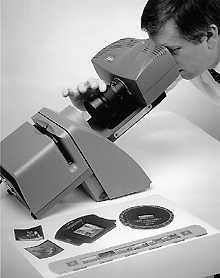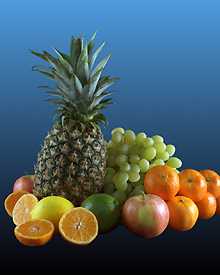
The Lumina is powered via a DC transformer, must be rigidly mounted, and is linked to the computer by a SCSI cable. Composition and focusing are carried out through a viewfinder on a groundglass screen with the inverted image of a view camera. The Lumina uses manual focus Nikon F mount lenses, and exploits their full field by covering a 28.5 x 35.5mm frame.
Its linear tri-colour CCD sensor records 12-bit red, green and blue signals simultaneously as it travels along the frame, driven by a stepper motor. It pauses to read each line of the final scan for a brief exposure time which can vary from 4.5 milliseconds to 250 msec. It can distinguish 1,024 grey shades or 4,096 colours.
With optimum lighting and lens aperture it can grab a preview or a small image in around ten seconds. But unless you have a fast PowerMac or Pentium PC with accelerated SCSI, exposure times can actually be from 90 seconds to six or seven minutes.
Setting the Lumina to give less exposure can reduce scan times but will sacrifice either shadow or highlight detail. The best overall gradation, lack of dark noise (grainy shadows) and freedom from frequency-induced banding is obtained with the default optimum exposure and a light-level plus lens aperture to yield scan times around 20-50 msec. If the times are over 100 msec, grainy coloured noise will appear in the shadows, and if they are less than 16 msec tungsten lights may show frequency-induced banding.
Working with three Scandles light-heads, apertures between f2.8 and f22 were possible with total exposure times between 30 seconds and 30 minutes (in practice, you would never use an aperture smaller than f11 in this lighting, as 6-8 minutes is about the longest exposure worth tolerating). With shutter speed and filmspeed set to match, the incident light reading was f5.6.
A black and white scan should be three times faster than an RGB scan but isn't. The only saving is in final file space on disk. Lumina software averages b/w luminance data from the RGB scan pass. If it didn't, a mono scan would depend on a single colour-filtered channel alone - like a shot taken through a green, blue or red filter.
The image preview has full controls over output resolution, cropping to size, tonal gradation and colour balance. Using them slows down image capture, especially with slower systems like the 40Mb RAM 25MHz Macintosh Quadra 660AV which we use.
A full frame copy scan at maximum resolution, yielding a 26.1Mb colour file, took only two minutes at f5.6 - but a cropped, scaled and adjusted scan from the same preview could take twice as long. The scanner always reads the full quantity of original data, and the software performs complex maths on the fly to create the file size and qualities you specify.
It can be faster to scan unadjusted at full resolution and area, and crop/rescale the image in Photoshop, with Photoshop Prefs set to Bicubic interpolation - the slow but clean option.
Overall speed is also affected by RAM available to Photoshop. The fastest data transfer is achieved without interpolation - as a full res scan - so you need to run Photoshop in at least 32Mb of memory to cope with an incoming 26Mb file, ideally in 80Mb. Reducing memory allocation, using a slower machine, or using virtual memory to make up for installed RAM shortfall will all slow down capture.

The Lumina's slide copying attachment, used a productive scanner for formats from 35mm to rollfilm
With the conditions right it was possible to preview, adjust, capture and save one full-page A4 high-res flat art scan every four minutes on our system Ð a minute to preview and initiate scan sequence, two minutes to scanning, and a minute to saving the file.
Fifteen scans an hour may not seem much to the outsider, but it is comparable to the fastest desktop transparency scanners and in excess of the throughput quoted for small drum scanners at ten times the Lumina's price.
Using the Express option provided by the Photoshop plug-in, you can scan many identically-sized similar originals in succession without a preview, and with auto set-up for the next scan when each is captured. This can permit batch scanning slides or art at 30-50 items per hour.
The Lumina has a triggering socket which will operate a DIN standard slide projector, and a converted Ektagraphic machine is available to handle up to 144 slides per magazine; the software includes batch name and save.
You can't discuss still life shots in the same terms, as each shot may take half an hour to set up, light, preview (which acts like a Polaroid), adjust and scan. One thing is certain - you couldn't shoot on film, get it processed, and then scan it on any other equipment in a shorter time.

The raw Lumina scan using auto white and black points and no 'toning' correction
The raw scan from a Lumina may seem flat to anyone used to lighting for slide film. It is best to think of the scan file as a kind of negative. Adjustments you make after scanning can transform the contrast and colour balance of the final print or repro. We found default Lumina scans rather lacking in vitality.
The corrected version, LEFT, has been adjusted as follows: Photoshop Saturation +30, Levels Gamma (centre point) to 0.85, White clipped to 225; Variations +2 clicks of Yellow, +1 click Red (midtones); 1 click Darker (shadows). The right-hand side version is retouched. To see either in a full size version, use the graphic links; when you have loaded up both examples, you can flick between them by clicking the pictures.

Finally, we dropped a graded background into the shot, as an example of how a digital picture can be altered if the client objects to the background you have picked.
The Lumina software offers no way of setting these up. The workround is to preview, draw the cropped image frame, and set and lock final repro dimensions. Then you type a very high pixel per inch figure in the resolution box, forcing the Lumina to use maximum resolution. It will display its calculated highest available resolution instead of the higher figure you typed in. This will usually not be an integer - it might be 652.6 dpi, for example.
You know you want a final image at 300dpi. If you change the resolution box to 300, the scan time will be long because of the resampling involved. Enter 326.3 (half of 652.6) instead, and you are telling the Lumina to resample at a straight 1:2 ratio, which involves less calculation and results in a very fast scan.
This is not an ideal solution, and the Lumina software should be rewritten to allow fixed maximum, half, quarter and one-eighth resolution settings. These would be similar to Photo-CD 4X, 2X, Base and 1/2X sizes.
As our early Lumina did not come with the now-free £1,500 35 and 120 slide scanning attachment, we decided to rig one up.
First efforts, using a Scandles light head and opal diffusor, were very poor because of low light levels, and required vast amounts of blackout to prevent flare.
We then tried a Meopta 100W 12V DC dichroic enlarger head with a 6 x 9cm mixing chamber. This provided brilliant illumination of the right quality and enabled exposure times as short as those for still life. Compared with over ten minutes to scan a slide at similar resolution in a Nikon CoolScan, or five minutes in our Leafscan 45, our three-minute capture time on the Lumina was pretty good for 26Mb 35mm or rollfilm slide scanning.
There is no frequency-induced image noise because the Czech-manufactured Meopta head (around £150 GB pounds) is DC, not AC. Enlarger carriers hold the originals and prevent instrusive flare, which the Lumina is prone to. The supplied IR cut-off filter is needed for good colour saturation. Though the Lumina is only a 12-bit scanner, scans show good shadow detail from modern transparency films and are as sharp as the lens will permit.
Current purchasers are supplied with a unit for scanning formats up to 6 x 7cm. Combined with a strong copy stand and some DC operated copy lights, or Kaiser flicker-free fluorescents, this makes the Lumina an efficient and cost-effective scanner.
We found Lumina scans from prints to be better than flatbed scans, as there is no glass platen to pick up dust and fingerprints, and the print surface can be lit to avoid textures picking up. For slide scanning, the Lumina was better than any 35mm desktop slide scanner we have yet tested. We used a 55mm Micro Nikkor; current Luminas are issued with a Sigma 50mm Macro capable of 1:1 repro without a further tube.
If we did not already own slide and print scanners, the Lumina could tackle every aspect of reproduction within Photon. As the Lumina provides a file big enough for A4 bleed, and can crop in on any area of an original, there is no work we have yet handled which it could not have covered.
For the price of £3,495 + VAT (GB pounds) including the slide illuminator, adding a copy stand and lights for around £1,500 more, the Lumina is not as compact as a desktop scanner - but it's everything a photographic studio entering the digital field needs for input of existing originals and photographing still life subjects. Marrutt Ltd, recently appointed as a Lumina reseller, also throw in their excellent Quay 2 Photoshop training CD-ROM worth £99.
UK sales of the Lumina remain primarily to the graphics sector as a scanner - few photographers have so far seen its potential. It requires a PowerMac costing around £3,000 (of which £1,000 is memory upgrade) and the addition of a 17 inch 24-bit colour screen for a further £1,000 (GB pounds). These have many other uses and can hardly be considered expenditure just to use with the Lumina.
The costs are directly comparable to investment in a small colour copier, a film processor, a professional enlarger, professional video or any one of a number of common capital investments for studios. It is no longer true to suggest that digital imaging prices itself out of the photographic market when equipment like this is available at such a low cost.